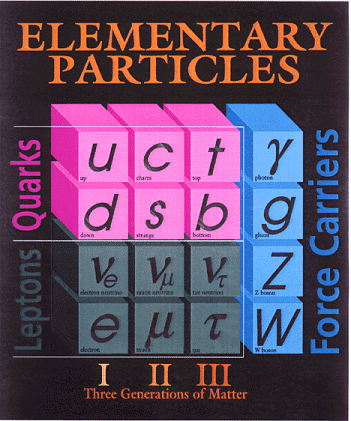email: 
email: 

A constant theme of this course will be the role that symmetry plays in dictating the structure of particle physics. And, while it is true that particle physics and high energy physics are nearly synonymous, they are not quite the same thing. We will see that it is possible to do particle physics at very low energy (e.g. investigating the upper mass limit of the electron neutrino via nuclear beta decay), similarly, it is possible to do nuclear physics at very high energy (e.g. the EMC effect). While we will be spending a lot of time discussing high energy physics topics, the course will cover the breadth of particle physics, from low energy to high.
The table at right shows the three generations of elementary particles and four types of force-carrying particles which together make up the standard model of elementary particles. This ``standard model'' has enjoyed unprecedented success in explaining elementary particle interactions. Yet, there are deeper mysteries that are yet undiscovered. For example, we see a striking similarity between the organization of the leptons and quarks. Symmetries such as these indicate a deeper organization of matter that future generations may uncover.
 List of Topics to be covered:
List of Topics to be covered: Some Sites That You Should Look At:
Some Sites That You Should Look At:This group is responsible for keeping the particle data booklet up to date with results from the latest particle physics discoveries. The site includes the latest particle listings, results of tests of conservation laws, summaries of major current particle physics experiments, as well as educational information.
The Crystal Barrel collaboration at CERN's Low Energy Antiproton Ring (LEAR) has taken the world's best Dalitz Plot data for the purpose of identifying mesons (meson spectroscopy) and exotic particles, such as glueballs. This site at Carnegie-Mellon University, Pittsburgh, PA, USA, highlights some of their more interesting Dalitz Plots, including clear interferences from competing channels.
This site provides a lot of information on the top quark identification in 1995, reference articles on the physics and methods of detection by both the CDF and D0 collaborations.
In late 1998, two experiments, one at CERN and the other at Fermilab, announced that they observed T violation in the K0-K0bar system. This result has long been anticipated, as T is required to be violated in this system if CPT is to be conserved. Browse these two sites to see how the two experiments are significantly different from each other.
It has been known for about 35 years that CP is violated in the K0-K0bar system, but until recently, it was never observed in any other system. Browse these sites on the various experiments on this system.
The most important particle physics announcement of the decade was made in June, 1998, when the Super-Kamiokande collaboration stated that they had found statistically significant evidence for neutrino oscillations, implying that neutrinos have non-zero mass. These measurements have recently been confirmed by the Sudbury Neutrino Observatory, leading to a potential resolution of the solar neutrino problem.
This magazine has published many excellent particle physics articles, written by top researchers in the field. Search their site for information on recent articles before making your trip to the library.
Interactive tour of particle physics. Quarks, neutrinos, unified forces and dark matter. Links to related materials. By M. Barnett, Lawrence Berkeley National Laboratory.
 Home Pages of Some Major High Energy
Physics Laboratories
Home Pages of Some Major High Energy
Physics LaboratoriesThese sites carry summaries of their lab's current scientific programs, major detector collaborations, recent major discoveries, and their plans for the near future.
And of course, let us not forget that particle physics invented the world wide web.
Read up on the early history of the WWW at CERN.